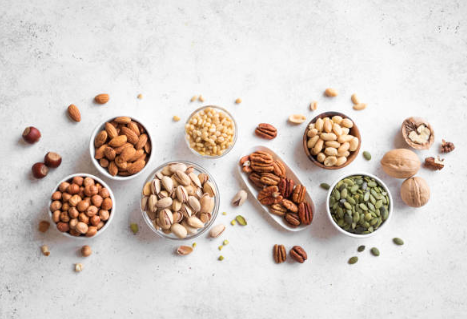Nuts are the ultimate plant-based powerhouse. They’re loaded with healthy fats and fiber, a wide range of vitamins and minerals, and—importantly—protein.
Your body needs a steady supply of amino acids, the building blocks of protein, to function properly. Protein plays a role in hormone and neurotransmitter production, nutrient absorption, and muscle development. A well-rounded diet should include a variety of protein-rich foods to meet these needs.
Unlike meat or eggs, which often require refrigeration and cooking, nuts are a shelf-stable, portable source of protein. You can stash them in your kitchen, desk drawer, or even your car—so you’re never without a satisfying snack.
Plus, nuts pair beautifully with both sweet and savory ingredients. Toss them in salads, grain bowls, baked goods, granola, oatmeal—even desserts—to easily sneak more protein into your meals.

1. Peanuts
7.43 grams of protein per ounce (roasted)
While technically a legume, peanuts are usually grouped with other nuts like almonds and cashews. They’re a staple in trail mixes and flavored nut blends—and peanut butter is a pantry must-have.
Peanuts are rich in plant protein, fiber, healthy fats, and nutrients like vitamin E and copper, which supports energy production and immune health.
Try chopped peanuts over oatmeal or salads, and use peanut butter in both sweet and savory recipes—from chia puddings and peanut noodles to hearty soups.
2. Almonds
6.01 grams of protein per ounce (whole)
Almonds are a smart pick for protein seekers. A single ounce provides over 6 grams of protein, plus a good dose of magnesium, which helps regulate blood sugar and blood pressure and supports stress response.
Most people fall short on magnesium, but just ¼ cup of almonds delivers about 18% of your daily needs.
Add sliced or chopped almonds to salads, bake with almond flour, or enjoy roasted almonds with fresh or dried fruit for a filling snack.
3. Pistachios
5.95 grams of protein per ounce (roasted)
These green gems are nearly a complete protein source, delivering close to 6 grams per serving. Plus, about 90% of the fat in pistachios is the heart-healthy unsaturated kind.
They’re also rich in potassium, a mineral that helps regulate blood pressure. A 2021 review of 21 studies found that pistachios had the most significant impact on reducing both systolic and diastolic blood pressure.
Because potassium is considered a “nutrient of public health concern” (most Americans don’t get enough), pistachios are a great snack to work into your day. Try mixing them with dried cherries for a sweet, salty, protein- and fiber-rich combo.
4. Cashews
4.34 grams of protein per ounce (roasted)
Cashews are buttery, smooth, and incredibly versatile—from snacking to baking to cooking. You can even blend them with dates, coffee, and collagen for a creamy non-dairy latte.
Studies suggest regular cashew intake can lower triglycerides, insulin levels, blood pressure, and LDL cholesterol—thanks to their fiber, minerals, and anti-inflammatory, antioxidant compounds.
5. Hazelnuts
4.25 grams of protein per ounce (roasted)
Often found in desserts and chocolate spreads, hazelnuts are equally tasty on their own or in savory dishes. They’re rich in protein, fiber, healthy fats, plus vitamins E and K, and manganese, a mineral vital for bone health, immune support, and metabolism.
Hazelnuts are also loaded with polyphenol antioxidants like gallic acid, catechins, and quercetin, which have strong anti-inflammatory and cell-protective effects.
6. Brazil Nuts
4.05 grams of protein per ounce (dried)
Brazil nuts offer protein, fiber, and several minerals, including copper, magnesium, and zinc—but their standout feature is selenium. These nuts are one of the richest dietary sources of selenium, which supports thyroid function, reproduction, and antioxidant activity through a group of proteins called selenoproteins.

7. Walnuts
4 grams of protein per ounce (roasted)
Walnuts are a diet staple for many and can be added to everything from oatmeal and granola to salads and yogurt parfaits. Their slightly sweet, mild flavor also makes them perfect in cookies and cakes.
They’re celebrated for their heart-health benefits, including reducing blood fats, improving vascular function, and lowering blood pressure.
Snack on whole walnuts or toss chopped ones over salads. You can also blend them into pesto with avocado, arugula, and lemon for a creamy, veggie-packed spread.
8. Pine Nuts
3.88 grams of protein per ounce (dried)
Technically seeds of pine trees, pine nuts are still categorized as tree nuts by the FDA. They have a soft texture and pine-like flavor, and they’re rich in vitamin E, magnesium, copper, manganese, and zinc—providing over 15% of your daily needs per ounce.
Pine nuts are also high in antioxidants like plant sterols and carotenoids, which help protect cells and reduce disease risk.
Easy Ways to Add More Nuts to Your Diet
There are endless creative ways to work nuts into snacks, meals, and even desserts:
-
Top your meals and snacks: Add a handful of nuts to just about anything—salads, stir-fries, yogurt, or oatmeal.
-
Use as a low-carb coating: Crush almonds or other nuts in a food processor and use them as a crunchy coating for chicken, fish, or roasted veggies.
-
Swap in nut flours for baking: Almond flour offers more protein, fiber, and healthy fats than white flour. Try it in muffins, cookies, cakes, and breads.
-
Make homemade energy bites: Blend nuts with dates or dried fruit to create protein- and fiber-packed snacks for the week.
-
Use nut butters for desserts: Peanut or almond butter makes a great base for wholesome, protein-rich sweet treats.
-
DIY granola and trail mix: Store-bought options are often full of added sugars. Make your own at home for better control over ingredients.
-
Keep individual snack packs handy: Pre-portioned mixed nut packs are perfect for the office, your car, or your gym bag.
-
Make nut-based pestos and sauces: Pine nuts, walnuts, or pistachios add flavor and protein to homemade pesto or herb sauces—great over pasta, roasted veggies, or grilled meats.